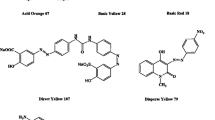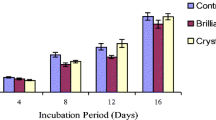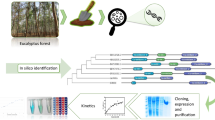Abstract
Laccases produced by white rot fungi have been extensively evaluated for their potential to decolorize textile wastewaters which contain salts like sodium chloride and sodium sulfate. The effect of sodium chloride and sodium sulfate on Trametes versicolor laccase during the decolorization of an anthraquinone dye (Reactive Blue 19) and the oxidation of 2,2′-azino-bis(3-ethylbenzothiazoline-6-sulfonic acid) (ABTS) were evaluated by steady-state kinetic analysis. The results showed that, while sodium sulfate did not affect laccase activity, sodium chloride inhibited both ABTS oxidation and dye decolorization. However, the type of inhibition was substrate-dependent: it was hyperbolic, noncompetitive with ABTS and parabolic, noncompetitive with Reactive Blue 19. Furthermore, the results suggested that two chlorides may bind to laccase in the presence of the dye unlike recent inhibition models which suggest that there is only one inhibition site. This investigation is the first to provide evidence for and to propose a two-site model of laccase inhibition, providing new insight into NaCl inhibition of laccase. The proposed model is also useful to predict decolorization rates in the presence of sodium chloride and to determine operating conditions that will minimize inhibition.






Similar content being viewed by others
References
Baldrian R (2006) Fungal laccases—occurrence and properties. FEMS Microbiol Rev 30:215–242
Cristovao RO, Tavares APM, Ribeiro AS, Loureiro JM, Boaventura RAR, Macedo EA (2008) Kinetic modelling and simulation of laccase catalyzed degradation of reactive textile dyes. Bioresour Technol 99:4768–4774
Cristovao RO, Tavares APM, Loureiro JM, Boaventura RAR, Macedi EA (2009) Treatment and kinetic modelling of a simulated dye house effluent by enzymatic catalysis. Bioresour Technol 100:6236–6242
Enaud E, Trovaslet M, Naveau F, Decristoforo A, Bizet S, Vanhulle S, Jolivalt C (2011) Laccase chloride inhibition reduction by anthraquinone substrate. Enzym Microb Technol 49:517–525
Gromov I, Marchesini A, Farver O, Pecht Im Goldfarb D (1999) Azide binding to the trinuclear copper center in laccase an ascorbate oxidase. Eur J Biochem 266:820–830
Hai FI, Yamamoto K, Fukushi K (2007) Hybrid treatment systems for dye wastewater. Crit Rev Environ Sci Technol 37:315–377
Jenkens FA, White HE (2001) Fundamentals of optics, 4th edn. McGraw-Hill College, New York
Koudelka GB, Ettinger MJ (1988) Fluoride effects in the activity of Rhus laccase and the catalytic mechanism under steady-state conditions. J Biol Chem 263:3698–3705
Leskovac V (2003) Comprehensive enzyme kinetics, 1st edn. Kluwer Academic, New York
Lewis DM (1999) Coloration in the next century. Rev Prog Color 29:23–28
Lu L, Zhao M, Liang SC, Zhao LY, Li DB, Zhang BB (2009) Production and synthetic dyes decolourization capacity of a recombinant laccase from Pichia pastoris. J Appl Microbiol 107:1149–1156
Mishra A, Kumar S (2009) Kinetic studies of laccase enzyme of Coriolus versicolor MTCC 138 in an inexpensive culture medium. Biochem Eng J 46:252–256
Moawad H, Abd El-Rahim WM, Khalafallah M (2003) Evaluation of biotoxicity of textile dyes using two bioassays. J Basic Microbiol 43:218–229
Moilanen U, Osma JF, Winquist E, Leisola M, Couto SR (2010) Decolorization of simulated dye baths by crude laccases from Trametes hirsuta and Cerrena unicolor. Eng Life Sci 10:242–247
Murugesan K, Nam IH, Kim YM, Chang YS (2007) Decolorization of reactive dyes by a thermostable laccase produced by Ganoderma lucidum in solid state culture. Enz Microb Technol 40:1662–1672
O’Neill C, Hawkes F, Hawkes D, Lourenco N, Pinheiro H, Delee W (1999) Colour in textile effluents—sources, measurement, discharge consents and simulation: a review. J Chem Technol Biotechnol 74:1009–1018
Orhon D, Germirli Babuna F, Kabdasli I, Insel FG, Karahan O, Dulkadiroglu H, Dogruel S, Sevimii F, Yediler A (2001) A scientific approach to wastewater recovery and reuse in the textile industry. Water Sci Technol 43(11):223–231
Peralta-Zamora P, Pereira CM, Tiburtius ERL, Moraes SG, Rosa MA, Minussi RC, Durán N (2003) Decolourization of reactive dyes by immobilized laccase. Appl Catal B Environ 42:131–144
Sadhasivam S, Savitha S, Swaminathan K (2009) Redox-mediated decolorization of recalcitrant textile dyes by Trichoderma harzianum WL1 laccase. World J Microbiol Biotechnol 25:1733–1741
Segel IH (1993) Enzyme kinetics: behaviour and analysis of rapid equilibrium and steady-state enzyme systems. Wiley-Interscience, New York
Torres E, Bustos-Jaimes I, Le Borgne S (2003) Potential use of oxidative enzymes for the detoxification of organic pollutants. Appl Catal B Environ 46:1–15
Trovaslet M, Enaud E, Guiavarc’h Y, Corbisier A-M, Vanhulle S (2007) Potential of a Pycnoporus sanguineus laccase in bioremediation of wastewater and kinetic activation in the presence of an anthraquinone acid dye. Enzym Microb Technol 41:368–376
Upadhyay SK (2006) Chemical and kinetics and reaction dynamics, 1st edn. Springer, New York
Vaz-Dominguez C, Campuzano S, Rudiger O, Pita M, Gorbacheva M, Shleev S, Fernandez VM, De Lacey AL (2008) Laccase electrode for direct electrocatalytic reduction of O2 to H2O with high-operational stability and resistance to chloride inhibition. Biosens Bioelectron 24:531–537
Vishnu G, Palanisamy S, Kurian J (2008) Assessment of field scale zero liquid discharge treatment systems for recovery of waste and salt from textile effluents. J Clean Prod 16:1081–1089
Wolfenden B, Wilson R (1982) Radical-cations as reference chromogens in kinetic studies of one-electron transfer reactions: pulse radiolysis studies of 2,2′-azinobis-(3-ethylbenzthiazoline-6-sulphonate). J Chem Soc Perkin Trans (7):805–812
Zilly A, Coelho-Moreira J, Bracht A, da Souza CGM, Carvajal AE, Koehnlein A, Peralta RM (2011) Influence of NaCl and Na2SO4 on the kinetics and dye decoloration ability of crude laccase from Ganoderma lucidum. Int Biodeterior Biodegrad 65:340–344
Acknowledgments
This research was financially supported by the Natural Science and Engineering Research Council of Canada; a Premier’s Research Excellence Award, Government of Ontario; and the Chancellor’s Award of Queen’s University as well as a Queen’s Graduate Award to P.-P. Champagne.
Author information
Authors and Affiliations
Corresponding author
Rights and permissions
About this article
Cite this article
Champagne, PP., Nesheim, M.E. & Ramsay, J.A. A mechanism for NaCl inhibition of Reactive Blue 19 decolorization and ABTS oxidation by laccase. Appl Microbiol Biotechnol 97, 6263–6269 (2013). https://doi.org/10.1007/s00253-012-4525-y
Received:
Revised:
Accepted:
Published:
Issue Date:
DOI: https://doi.org/10.1007/s00253-012-4525-y




